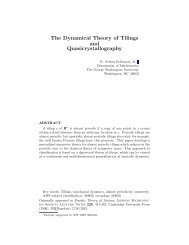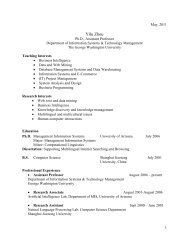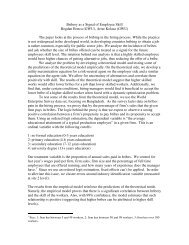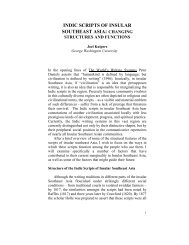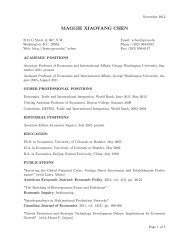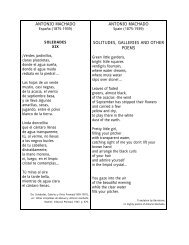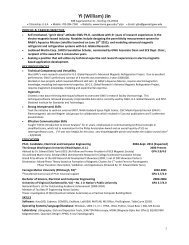Syllabus - gwu.edu - George Washington University
Syllabus - gwu.edu - George Washington University
Syllabus - gwu.edu - George Washington University
You also want an ePaper? Increase the reach of your titles
YUMPU automatically turns print PDFs into web optimized ePapers that Google loves.
INTERNATIONAL AFFAIRS 3180.80/POLITICAL SCIENCE 2990.80<br />
CIVIL WAR, INSURGENCY, AND TERRORISM<br />
Elliott School of International Affairs<br />
The <strong>George</strong> <strong>Washington</strong> <strong>University</strong><br />
Fall 2012 Professor: Alexander B. Downes<br />
Time: Tues/Thurs., 12.45-2.00PM Office: 1957 E St. NW, #605B<br />
Room: Duques 359 Phone: 202.994.7859<br />
Office Hours: Tuesday, 3.30-5.00PM Email: downes@<strong>gwu</strong>.<strong>edu</strong><br />
COURSE DESCRIPTION<br />
Civil war is the most common form of state-based armed conflict today. Depending on how one counts, between<br />
110 and 260 civil wars have been fought since the end of World War II, compared to 30 to 45 interstate wars. Civil<br />
wars are also extremely deadly, causing the deaths of millions of people, the majority of them noncombatants. The<br />
end of the Cold War focused the attention of scholars of comparative politics and international relations on civil<br />
conflict, leading to a growing literature on all facets of civil war, including civil war onset, duration, outcome, and<br />
termination; causes and effectiveness of targeting civilians (a.k.a., terrorism) in civil wars; why people join rebel<br />
groups or decide to become terrorists; the effectiveness of various forms of intervention in civil wars;<br />
counterinsurgency; and more.<br />
This course explores some of the new literature on civil war, and is divided into four parts. The first part is mainly<br />
definitional: what is a civil war? What kinds of civil wars are there? What are insurgency and counterinsurgency?<br />
What is terrorism? These class sessions outline working definitions for each of these phenomena that we will use<br />
during the remainder of the course.<br />
The second section of the course looks at the causes of civil war. War is a costly and risky endeavor, and rebels face<br />
particularly steep odds going up against states that are typically far more powerful. Why then do civil wars occur?<br />
Which kinds of factors increase the odds that civil conflict will break out? This section covers the greed versus<br />
grievance debate that has dominated the literature for the past two decades, but also examines the role of political<br />
leaders, institutions, and external actors in provoking or mediating the outbreak of violence.<br />
The third part of the course turns to the conduct of civil wars with an emphasis on one particularly prevalent but<br />
unsavory practice: violence against civilians. Civil wars—the majority of which are waged as guerrilla<br />
insurgencies—place the civilian population directly in the middle of the contest: insurgents need civilian support to<br />
survive and thrive, while the government seeks to deny rebels access to the population. Both sides use violence as a<br />
resource to compel collaboration and deter defection. This type of “terrorism” is both very common and<br />
underappreciated. This part of the course will study the causes and effectiveness of this kind of terrorism, as well as<br />
terrorism perpetrated by groups specifically labeled as terrorist organizations. We will also look specifically at<br />
counterinsurgency, including less violent strategies like “hearts and minds” and “decapitation,” as well as the effect<br />
of ethnicity on violence and why individuals choose to join rebel groups.<br />
The final section of the course looks at what makes civil wars last so long and what eventually brings them to an<br />
end. Specific topics covered include civil war duration, cohesion of rebel groups, and civil war outcomes. Of<br />
particular interest is the question of what (if anything) outsiders can do to facilitate the termination of civil wars and<br />
prevent their recurrence. To that end, we spend several class sessions on different types of settlements to civil wars<br />
and different methods of international engagement.<br />
It is important to note that this class is not about any particular civil war(s). Rather, the course is devoted to<br />
explaining the causes, conduct, and termination of civil wars in general, or to explaining these phenomena in a<br />
handful of different types of civil wars. We will draw on examples from many different conflicts, including (but<br />
probably not limited to) civil wars in Afghanistan, Algeria, Chechnya, Colombia, DRC, El Salvador, Greece, Iraq,<br />
Kashmir, Libya, Mozambique, Pakistan, Palestinian Territories, Peru, Rwanda, South Africa, Spain, Syria, Uganda,<br />
United States, Vietnam, and former Yugoslavia.
Prof. Downes IAFF 3180.80/PSC 2990.80 <strong>Syllabus</strong> Fall 2012<br />
COURSE REQUIREMENTS AND GRADE COMPUTATION<br />
The course is organized into two meetings of one hour and fifteen minutes per week. Grades will be based on the<br />
following criteria.<br />
� Class Attendance and Participation (20%): Students are expected to attend every class session, do all of<br />
the required reading before class, and come prepared to discuss it. The instructor will not lecture for the<br />
entire period. Questions are provided below for each session that will form the basis for discussion. You<br />
will be called on by the instructor at some point during the semester, so do keep up with the reading.<br />
� Midterm Examination (15%): Thursday, October 4. In-class, closed-book short-answer exam covering<br />
the first two sections of the course.<br />
� Final Examination (20%): Tuesday, December 18, 12.40 – 2.40PM. Cumulative, closed-book final exam,<br />
consisting of short answers and essays, emphasizing the last two sections of the course.<br />
� Research Paper (45%): due Friday, December 7, by 5.00PM in HARD COPY at instructor’s office, circa<br />
20 pages. See below for more details.<br />
Final grades will be calculated according to the percentages above, and will be assigned as follows: A (93-100), A-<br />
(90-92), B+ (87-89), B (83-86), B- (80-82), C+ (77-79), C (73-76), C- (70-72), D+ (67-69), D (63-66), D- (60-62),<br />
and F (0-59). Grades for this course will not be curved.<br />
BOOKS<br />
The following books are required reading and are available for purchase at The <strong>George</strong> <strong>Washington</strong> <strong>University</strong><br />
Bookstore.<br />
Stathis N. Kalyvas, The Logic of Violence in Civil War (Cambridge: Cambridge <strong>University</strong> Press, 2006).<br />
Jeremy Weinstein, Inside Rebellion: The Politics of Insurgent Violence (Cambridge: Cambridge <strong>University</strong> Press,<br />
2007).<br />
ARTICLES AND BOOK CHAPTERS<br />
All of the journal articles listed in the required reading below—unless otherwise indicated—are available online in<br />
databases accessible through the <strong>George</strong> <strong>Washington</strong> <strong>University</strong> Library. From the library website<br />
(http://www.library.<strong>gwu</strong>.<strong>edu</strong>/), click the “Journals” tab, search for the desired title, and navigate to the correct<br />
volume and issue. If you are accessing the library website from off campus, you will need to enter your last name<br />
and your GWID to obtain access. For several class sessions I have assigned book chapters in addition to journal<br />
articles. These are placed on E-Reserve, and are indicated by the term “e-res” in parentheses after the citation. These<br />
texts are easily obtained through the Blackboard site that has been established for the class. Click on “Blackboard”<br />
from the “My GW” page (http://my.<strong>gwu</strong>.<strong>edu</strong>), log in, go to the page for this class, and click on “E-Reserves.”<br />
RESEARCH PAPER<br />
In consultation with the instructor, students will select a civil war about which they will write a research paper. The<br />
goal of the paper will not be to “explain” the entire conflict from start to finish. Rather, following the outline of the<br />
syllabus, students will write about the causes, conduct, or termination of their chosen conflict. From within these<br />
broad categories, students will choose (in consultation with the instructor) a specific question (or, in rare cases,<br />
questions) to answer about the war, such as:<br />
� Which factor or combination of factors best explains why civil war occurred?<br />
� What patterns of violence characterized the conflict, and what explains them?<br />
� Was violence/terrorism effective?<br />
2
Prof. Downes IAFF 3180.80/PSC 2990.80 <strong>Syllabus</strong> Fall 2012<br />
� Why did one side prevail?<br />
� If the conflict was protracted, what explains why it lasted so long?<br />
� Was there external intervention, and did it facilitate a lasting settlement?<br />
� If the conflict reignited, why did peace fail to last?<br />
Papers are expected to engage the theoretical literature examined in class that relates to the question addressed in the<br />
paper. Papers that attempt to explain civil war onset, for example, should incorporate the literature from Part II of<br />
the course on causes of civil war.<br />
All students must turn in a one-page memo in class on September 20 that performs four tasks:<br />
� Specifies which war will be the focus of your paper<br />
� Specifies which specific aspect of the conflict you intend to explore<br />
� Provides a short background and summary of the conflict<br />
� Lists 3-5 books or articles you have identified as potential sources of information<br />
Students are encouraged to meet with the instructor at their earliest convenience to discuss their interests and get<br />
started on the paper. It is not mandatory to have a meeting before the memo is due, but the instructor will sch<strong>edu</strong>le<br />
conferences with each student after the memos are turned in. See the appendix at the end of the syllabus for some<br />
resources on civil wars to help you get started.<br />
GOALS OF THE COURSE<br />
The most important goal of the course is to impart to students a solid understanding of theories and empirical<br />
evidence regarding the causes, conduct, and termination of civil wars. This will be achieved by reading the required<br />
material, discussing it in class, and responding to questions about the readings on the exams. The second major goal<br />
is for students to obtain detailed knowledge of at least one civil war by writing a research paper on some aspect of<br />
that conflict. Additional goals include the following:<br />
� Educate students regarding the different types of civil wars that exist<br />
� Unpack the different forms of violence that are currently consolidated under the rubric of “terrorism”<br />
� Examine the different strategies that states use to combat insurgencies<br />
� Evaluate the relative merits of strategies that use a lot of violence versus those that use minimal violence<br />
� Within the category of violence, evaluate the relative merits of selective versus indiscriminate violence<br />
� Understand how civil wars end, and which endings prove more stable than others<br />
� Help students learn how to read social science research and not only understand it, but criticize it<br />
LEARNING OUTCOMES<br />
At the end of the course, students should be able to:<br />
� Distinguish among different types of civil wars<br />
� Identify risk factors that make states vulnerable to civil war, and which make social groups more likely to<br />
launch a rebellion<br />
� Determine which civil wars are more prone to violence and terrorism against noncombatants, and what type<br />
of violence it will be<br />
� Evaluate the relative efficacy of different forms of violence used by actors in civil wars, and the conditions<br />
under which these strategies may be more or less effective<br />
� Evaluate the merits of low versus high violence counterinsurgency strategies<br />
� Make informed conjectures about which civil wars will last longer, and which side will prevail<br />
� Critically evaluate social science theories, not only those about civil wars, but theories in general<br />
3
Prof. Downes IAFF 3180.80/PSC 2990.80 <strong>Syllabus</strong> Fall 2012<br />
POLICIES AND RESOURCES<br />
� Class Policies<br />
o Attendance and Reading: Students are expected to attend every class session, do all of the<br />
assigned reading before class, and come prepared to discuss it. Exceptions will of course be made<br />
for religious holidays. Students who know they will miss class owing to observance of a religious<br />
holiday need to notify the instructor during the first week of the semester.<br />
o Late Papers: Late papers will be accepted up to 24 hours after the deadline, but one letter grade<br />
will be d<strong>edu</strong>cted. Papers that are more than 24 hours late will not be accepted. Exceptions will be<br />
made only in cases of incapacitating illness or extraordinary personal or family emergency; if you<br />
find yourself in such a situation, consult the instructor as soon as possible to discuss an extension.<br />
o Exams: Students must take the final exam at the time and date assigned by the Academic<br />
Sch<strong>edu</strong>ling Office. Students who have three final exams on one day may petition for one of them<br />
to be resch<strong>edu</strong>led. Note that this must be done at least three weeks prior to the last day of classes:<br />
see http://www.<strong>gwu</strong>.<strong>edu</strong>/~regweb/web-content/sch<strong>edu</strong>ling/exam_policies.html.<br />
o Technology: Laptops are allowed in class for note-taking purposes only, not for checking e-mail,<br />
Facebook, surfing the web or online shopping. Note that the use of laptops is a privilege that can<br />
be taken away if it is abused! The only cell phones allowed in class are those that have been turned<br />
off.<br />
� Plagiarism, Cheating, and Academic Integrity. According to the university’s Code of Academic<br />
Integrity, “Academic dishonesty is defined as cheating of any kind, including misrepresenting one’s own<br />
work, taking credit for the work of others without crediting them and without appropriate authorization, and<br />
the fabrication of information.” For the rest of the code, see http://www.<strong>gwu</strong>.<strong>edu</strong>/~ntegrity/code.html. In<br />
general, I expect that you will not lie, cheat, steal, or otherwise conduct yourselves dishonorably, and will<br />
do something if you observe others engaging in such conduct. All work you submit for this course must be<br />
your own. I will not tolerate any form of academic dishonesty. Suspected cases will be referred to the<br />
Office of Academic Integrity. If you have questions about what constitutes proper use of published or<br />
unpublished sources, please ask the instructor.<br />
� Disabilities. Any student who may need an accommodation based on the potential impact of a disability<br />
should contact the Disability Support Services office at 202.994.8250 in the Marvin Center, Suite 242, to<br />
establish eligibility and to coordinate reasonable accommodations. For additional information please refer<br />
to: http://gwired.<strong>gwu</strong>.<strong>edu</strong>/dss/.<br />
� Counseling. The <strong>University</strong> Counseling Center (UCC, 202.994.5300) offers 24/7 assistance and referral to<br />
address students’ personal, social, career, and study skills problems. Services for students include crisis and<br />
emergency mental health consultations, confidential assessment, counseling services (individual and small<br />
group), and referrals (see http://gwired.<strong>gwu</strong>.<strong>edu</strong>/counsel/CounselingServices/AcademicSupportServices).<br />
� Security. In the case of an emergency, if at all possible, the class should shelter in place. If the building<br />
that the class is in is affected, follow the evacuation proc<strong>edu</strong>res for the building. After evacuation, seek<br />
shelter at a predetermined rendezvous location.<br />
4
Prof. Downes IAFF 3180.80/PSC 2990.80 <strong>Syllabus</strong> Fall 2012<br />
COURSE CALENDAR<br />
Part I. Introduction and Definitions<br />
1. August 28 (Tu) Course Introduction<br />
2. August 30 (Th) No Class<br />
3. September 4 (Tu) Definitions I<br />
4. September 6 (Th) Definitions II<br />
Part II. Causes of Civil War<br />
5. September 11 (Tu) Psychology<br />
6. September 13 (Th) Ethnicity and the State<br />
7. September 18 (Tu) Opportunity/Greed<br />
8. September 20 (Th) Return to Grievances PAPER TOPICS DUE<br />
9. September 25 (Tu) Democracy and Democratization<br />
10. September 27 (Th) Leaders and within-Group Conflict<br />
11. October 2 (Tu) External Sources of Internal Conflict<br />
12. October 4 (Th) MIDTERM EXAM<br />
Part III. Conduct of Civil War<br />
13. October 9 (Tu) Causes of Violence and Terrorism I<br />
14. October 11 (Th) Causes of Violence and Terrorism II<br />
15. October 16 (Tu) Causes of Violence and Terrorism III<br />
16. October 18 (Th) Effectiveness of Violence and Terrorism I<br />
17. October 23 (Tu) Effectiveness of Violence and Terrorism II<br />
18. October 25 (Th) Alternatives to High Violence COIN I<br />
19. October 30 (Tu) Alternatives to High Violence COIN II<br />
20. November 1 (Th) Case Study: Iraq<br />
21. November 6 (Tu) Rebel Recruitment/Individual Participation<br />
22. November 8 (Th) Ethnicity and Violence<br />
Part IV. Civil War Duration, Outcome, Termination, and Aftermath<br />
23. November 13 (Tu) Civil War Duration<br />
24. November 15 (Th) Rebel Group Cohesion and Fragmentation<br />
25. November 20 (Tu) Civil War Outcomes<br />
26. November 22 (Th) NO CLASS: THANKSGIVING<br />
27. November 27 (Tu) Ending Civil Wars I<br />
28. November 29 (Th) Ending Civil Wars II<br />
29. December 4 (Tu) Ending Civil Wars III<br />
30. December 6 (Th) Perverse Consequences of Intervention PAPERS DUE DEC. 7<br />
31. December 10 (M) Make-Up Day: Course Wrap-up and Review<br />
32. December 18 (Tu) FINAL EXAM<br />
5
Prof. Downes IAFF 3180.80/PSC 2990.80 <strong>Syllabus</strong> Fall 2012<br />
COURSE SCHEDULE<br />
Part I. Introduction and Definitions<br />
1. Course Introduction August 28<br />
� Lotta Themnér and Peter Wallensteen, “Armed Conflicts, 1946-2011,” Journal of Peace Research<br />
49, no. 4 (July 2012): 565-575.<br />
2. No Class: American Political Science Association Annual Meeting August 30<br />
� Get a head start on the reading for next week.<br />
3. Definitions, Part I September 4<br />
� Nicholas Sambanis, “What Is Civil War? Conceptual and Empirical Complexities of an<br />
Operational Definition,” Journal of Conflict Resolution 48, no. 6 (December 2004): 814-858 (read<br />
814-831 and 853-857; skim the remainder).<br />
� Stathis N. Kalyvas and Laia Balcells, “International System and Technologies of Rebellion: How<br />
the End of the Cold War Shaped Internal Conflict,” American Political Science Review 104, no. 3<br />
(August 2010): 415-429.<br />
� Stathis N. Kalyvas, “‘New’ and ‘Old’ Civil Wars: A Valid Distinction?” World Politics 54, no. 1<br />
(October 2001): 99-118.<br />
Discussion Questions:<br />
� What kinds of conflicts are included and excluded by mainstream definitions of civil war? Are<br />
these inclusions/exclusions justified? Why?<br />
� What are the different ways that scholars categorize civil wars? What are the key axes along which<br />
these conflicts vary?<br />
� Has the nature of civil war changed over time?<br />
4. Definitions, Part II September 6<br />
� Che Guevara, Guerrilla Warfare (New York: Monthly Review Press, 1961), 7-37 (e-res).<br />
� John A. Nagl, Learning to Eat Soup with a Knife: Counterinsurgency Lessons from Malaya and<br />
Vietnam (Chicago: <strong>University</strong> of Chicago Press, 2002), 15-33 (e-res).<br />
� Kalyvas, Logic of Violence in Civil War, 16-31.<br />
� Bruce Hoffman, Inside Terrorism (New York: Columbia <strong>University</strong> Press, 1998), 13-44 (e-res).<br />
Discussion Questions:<br />
� What distinguishes guerrilla warfare/insurgency from conventional war?<br />
� What is terrorism?<br />
� Is terrorism limited to non-state actors, or can states be terrorists too?<br />
Part II. Causes of Civil War<br />
5. Psychology: Relative Deprivation and Group Comparison September 11<br />
� Ted Robert Gurr, “Psychological Factors in Civil Violence,” World Politics 20, no. 2 (January<br />
1968): 245-278.<br />
� Donald L. Horowitz, Ethnic Groups in Conflict (Berkeley: <strong>University</strong> of California Press, 1985),<br />
141-184 (e-res).<br />
� Roger Petersen, Understanding Ethnic Violence: Fear, Hatred, and Resentment in Twentieth-<br />
Century Eastern Europe (Cambridge: Cambridge <strong>University</strong> Press, 2002), 17-61 (e-res).<br />
6
Prof. Downes IAFF 3180.80/PSC 2990.80 <strong>Syllabus</strong> Fall 2012<br />
Discussion Questions:<br />
� What is relative deprivation?<br />
� Why does comparison invite conflict?<br />
� Is inter-group conflict emotional?<br />
6. Ethnicity and the State September 13<br />
� Barry R. Posen, “The Security Dilemma and Ethnic Conflict,” Survival 35, no. 1 (1993): 27-47 (eres).<br />
� James D. Fearon, “Commitment Problems and the Spread of Ethnic Conflict,” in The<br />
International Spread of Ethnic Conflict: Fear, Diffusion, and Escalation, ed. David Lake and<br />
Donald Rothchild (Princeton, N.J.: Princeton <strong>University</strong> Press, 1998), 107-126 (e-res).<br />
� James D. Fearon and David D. Laitin, “Sons of the Soil, Migrants, and Civil War,” World<br />
Development 39, no. 2 (February 2011): 199-211.<br />
Discussion Questions:<br />
� What is the security dilemma and how does it cause civil war? Is the security dilemma a<br />
persuasive explanation for civil war in Yugoslavia?<br />
� Is Fearon’s argument different from Posen’s argument? How?<br />
� How do commitment problems contribute to “sons of the soil” conflicts?<br />
7. Opportunity/Greed September 18<br />
� Paul Collier, “Doing Well Out of War: An Economic Perspective,” in Greed and Grievance:<br />
Economic Agendas in Civil Wars, ed. Mats Berdal and David M. Malone (Boulder, Colo.: Lynne<br />
Rienner, 2000), 91-111 (e-res).<br />
� James D. Fearon and David D. Laitin, “Ethnicity, Insurgency, and Civil War,” American Political<br />
Science Review 97, no. 1 (February 2003): 75-90.<br />
� Michael L. Ross, “How Do Natural Resources Influence Civil War? Evidence from Thirteen<br />
Cases,” International Organization 58 (Winter 2004): 35-67.<br />
Discussion Questions:<br />
� How do Collier and F&L interpret low GDP? Whose interpretation do you believe?<br />
� What do you think of how Collier and F&L operationalize their key concepts?<br />
� What role do natural resources play in causing civil conflict? How consistent are these causal<br />
mechanisms with the greed hypothesis?<br />
8. The Return to Grievances September 20<br />
Paper Topics Due<br />
� Frances Stewart, “Horizontal Inequalities and Conflict: An Introduction and some Hypotheses,” in<br />
Horizontal Inequalities and Conflict: Understanding Group Violence in Multiethnic Societies, ed.<br />
Frances Stewart (Houndmills: Palgrave Macmillan, 2008), 3-24 (e-res).<br />
� Lars-Erik Cederman, Nils B. Weidmann, and Kristian Skrede Gleditsch, “Horizontal Inequalities<br />
and Ethnonationalist War: A Global Comparison,” American Political Science Review 105, no. 3<br />
(August 2011): 478-495.<br />
� Nicholas Sambanis, “Using Case Studies to Expand Economic Models of Civil War,”<br />
Perspectives on Politics 2, no. 2 (June 2004): 259-279.<br />
� David Keen, “Greed and Grievance in Civil War,” International Affairs, Vol. 88, No. 4 (July<br />
2012): 757-777.<br />
Discussion Questions:<br />
� Which do you find more persuasive, grievance explanations or greed/opportunity explanations?<br />
� Can greed or grievance alone explain civil war, or must they both be present?<br />
� What role do case studies play in evaluating these theories, and theories in general?<br />
7
Prof. Downes IAFF 3180.80/PSC 2990.80 <strong>Syllabus</strong> Fall 2012<br />
9. Democracy and Democratization September 25<br />
� Håvard Hegre, Tanja Ellingsen, Scott Gates, and Nils Petter Gleditsch, “Toward a Democratic<br />
Civil Peace? Democracy, Political Change, and Civil War, 1816-1992,” American Political<br />
Science Review 95, no. 1 (March 2001): 33-48.<br />
� Lars-Erik Cederman, Simon Hug, and Lutz F. Krebs, “Democratization and Civil War: Empirical<br />
Evidence,” Journal of Peace Research 47, no. 4 (July 2010): 377-394.<br />
Discussion Questions:<br />
� What is the logic for why different political regimes have different propensities for civil war?<br />
� Is democratization a force for civil peace or civil war?<br />
� Do consolidated democracies ever have civil wars? If so, why?<br />
10. Leaders and within-Group Conflict September 27<br />
� Michael E. Brown, “The Causes and Regional Dimensions of Internal Conflict,” in The<br />
International Dimensions of Internal Conflict, ed. Michael E. Brown (Cambridge, Mass.: MIT<br />
Press, 1996), 571-601 (e-res).<br />
� V. P. Gagnon, Jr., “Ethnic Nationalism and International Conflict: The Case of Serbia,”<br />
International Security 19, no. 3 (Winter 1994/95): 130-166.<br />
� Adria Lawrence, “Triggering Nationalist Violence: Competition and Conflict in Uprisings against<br />
Colonial Rule,” International Security 35, no. 2 (Fall 2010): 88-122.<br />
Discussion Questions:<br />
� Is it true that the outbreak of civil war has nothing to do with animosity against the state or other<br />
groups? Is it all about within-group conflict and leader survival strategies?<br />
� According to Posen, the security dilemma caused the wars in former Yugoslavia. Not so, says<br />
Gagnon. Who is right?<br />
11. External Sources of Internal Conflict October 2<br />
� Idean Salehyan, Rebels without Borders: Transnational Insurgencies in World Politics (Ithaca,<br />
N.Y.: Cornell <strong>University</strong> Press, 2009), 26-60 (e-res).<br />
� Alexander B. Downes, “Catastrophic Success: Foreign-Imposed Regime Change and Civil War,”<br />
unpublished ms., <strong>George</strong> <strong>Washington</strong> <strong>University</strong>, 2012 (e-res).<br />
Discussion Questions:<br />
� What are the various ways that external factors can cause civil wars?<br />
� Is foreign-imposed regime change a force for peace or a force for war? Under what conditions?<br />
12. Midterm Exam October 4<br />
Part III. Conduct of Civil Wars<br />
13. Causes of Violence and Terrorism in Civil War, Part I October 9<br />
� Thucydides, History of the Peloponnesian War, trans. by Rex Warner (London: Penguin Books,<br />
1954), 236-245 (“Civil War on Corcyra”) (e-res).<br />
� Kaylvas, Logic of Violence in Civil War, 111-145, 173-209.<br />
Discussion Questions:<br />
� What is the difference between selective and indiscriminate violence? Where is each type of<br />
violence most likely to occur in Kalyvas’s model?<br />
8
Prof. Downes IAFF 3180.80/PSC 2990.80 <strong>Syllabus</strong> Fall 2012<br />
14. Causes of Violence and Terrorism in Civil War, Part II October 11<br />
� Weinstein, Inside Rebellion, 1-24 and 198-259.<br />
� Lisa Hultman, “Battle Losses and Rebel Violence: Raising the Costs for Fighting,” Terrorism and<br />
Political Violence 19, no. 2 (Summer 2007): 205-222.<br />
� Laia Balcells, “Rivalry and Revenge: Violence against Civilians in Conventional Civil Wars,”<br />
International Studies Quarterly 54, no. 2 (June 2010): 291-313.<br />
Discussion Questions:<br />
� What are the key differences in the predictions of Kalyvas’s and Weinstein’s theories?<br />
� Does the empirical evidence cited in Weinstein’s chapter support his theory?<br />
� How does violence against civilians differ in conventional and guerrilla wars?<br />
15. Causes of Violence and Terrorism in Civil War, Part III October 16<br />
� Robert A. Pape, “The Strategic Logic of Suicide Terrorism,” American Political Science Review<br />
97, no. 3 (August 2003): 343-361.<br />
� Mia M. Bloom, “Palestinian Suicide Bombing: Public Support, Market Share, and Outbidding,”<br />
Political Science Quarterly 119, no. 1 (Spring 2004): 61-88.<br />
� Assaf Moghadam, “Motives for Martyrdom: Al-Qaida, Salafi Jihad, and the Spread of Suicide<br />
Attacks,” International Security 33, no. 3 (Winter 2009): 46-78.<br />
� James A. Piazza, “A Supply-Side View of Suicide Terrorism: A Cross-National Study,” Journal<br />
of Politics 70, no. 1 (January 2008): 28-39.<br />
Discussion Questions:<br />
� What is the role of religion in causing suicide terrorism? Are secular or sacred factors more<br />
important in causing suicide terrorism?<br />
� Are there different policy implications that flow from different theories about the origins of<br />
suicide terrorism?<br />
� Have I created a selection bias by assigning readings only on suicide terrorism instead of terrorism<br />
in general?<br />
16. Effectiveness of Violence and Terrorism in Civil War, Part I October 18<br />
� Kalyvas, Logic of Violence in Civil War, 146-172.<br />
� Jason M. Lyall, “Does Indiscriminate Repression Incite Insurgent Attacks? Evidence from<br />
Chechnya,” Journal of Conflict Resolution 53, no. 3 (2009): 331-362.<br />
� Matthew Adam Kocher, Thomas B. Pepinsky, and Stathis N. Kalyvas, “Aerial Bombing and<br />
Counterinsurgency in the Vietnam War,” American Journal of Political Science 55, no. 2 (March<br />
2011): 201-218.<br />
� Alexander B. Downes, “Draining the Sea by Filling the Graves: Investigating the Effectiveness of<br />
Indiscriminate Violence as a Counterinsurgency Strategy,” Civil Wars 9, no. 4 (December 2007):<br />
420-444.<br />
Discussion Questions:<br />
� Is indiscriminate violence an effective or ineffective tool of counterinsurgency? Are there<br />
conditions under which it might be more or less effective?<br />
9
Prof. Downes IAFF 3180.80/PSC 2990.80 <strong>Syllabus</strong> Fall 2012<br />
17. Effectiveness of Violence and Terrorism in Civil War , Part II October 23<br />
� Review Pape, “Strategic Logic of Suicide Terrorism.”<br />
� Max Abrahms, “Why Terrorism Does Not Work,” International Security 31, no. 2 (Fall 2006): 42-<br />
78.<br />
Discussion Questions:<br />
� Why do Pape and Abrahms reach opposite conclusions about the effectiveness of terrorism? Is one<br />
right and the other wrong?<br />
� Do Pape and Abrahms actually disagree? If not, why not?<br />
� Is a suicide attack against a military base or against off-duty soldiers an act of terrorism?<br />
18. Alternatives to High Violence in COIN, Part I: The Population-Centric Strategy October 25<br />
� David Galula, Counterinsurgency Warfare: Theory and Practice (New York: Praeger, 1964), 107-<br />
135 (e-res).<br />
� FM 3-24: Counterinsurgency (<strong>Washington</strong>, D.C.: Department of the Army, December 2006),<br />
Chapter 1, available online at http://www.fas.org/irp/doddir/army/fm3-24.pdf (a.k.a., The U.S.<br />
Army/Marine Counterinsurgency Field Manual).<br />
� <strong>George</strong> Packer, “Letter from Iraq: The Lesson of Tal Afar,” The New Yorker, April 10, 2006, 48-<br />
65.<br />
Discussion Questions:<br />
� What key assumptions underlie the population-centric COIN strategy? Are these assumptions met<br />
in most insurgencies?<br />
� What are the big successes of the population-centric strategy in the historical record?<br />
� Is the population-centric strategy likely to bring stability to Afghanistan?<br />
19. Alternatives to High Violence in COIN, Part II: Decapitation October 30<br />
� Jenna Jordan, “When Heads Roll: Assessing the Effectiveness of Leadership Decapitation,”<br />
Security Studies 18, no. 4 (December 2009): 719-755.<br />
� Bryan C. Price, “Targeting Top Terrorists: How Leadership Decapitation Contributes to<br />
Counterterrorism,” International Security 36, no. 4 (Spring 2012): 9-46.<br />
Discussion Questions:<br />
� Which of these two studies do you find most persuasive and why?<br />
� Does the U.S.’s advantage in precision airpower give it a silver bullet in COIN and counterterrorism?<br />
20. Case Study: Iraq November 1<br />
� Stephen Biddle, Jeffrey A. Friedman, and Jacob N. Shapiro, “Testing the Surge: Why Did<br />
Violence Decline in Iraq in 2007?” International Security 37, no. 1 (Summer 2012): 7-40.<br />
� Douglas Ollivant, “Countering the New Orthodoxy: Reinterpreting Counterinsurgency in Iraq,”<br />
New America Foundation Policy Paper, June 28, 2011 (e-res).<br />
� John Agnew, Thomas W. Gillespie, Jorge Gonzalez, and Brian Min, “Baghdad Nights: Evaluating<br />
the U.S. Military ‘Surge’ Using Nighttime Light Signatures,” Environment and Planning 40, no.<br />
10 (2008): 2285-2295.<br />
� Austin Long, “The Anbar Awakening,” Survival 50, no. 2 (April/May 2008): 67-94.<br />
Discussion Questions:<br />
� Which argument do you find most persuasive for the decline in violence in Iraq?<br />
� What implications does your answer have for U.S. efforts to pacify Afghanistan?<br />
10
Prof. Downes IAFF 3180.80/PSC 2990.80 <strong>Syllabus</strong> Fall 2012<br />
21. Rebel Recruitment/Individual Participation November 6<br />
� Weinstein, Inside Rebellion, 96-126.<br />
� Stathis N. Kalyvas, and Matthew Adam Kocher, “How ‘Free’ is Free Riding in Civil Wars?<br />
Violence, Insurgency, and the Collective Action Problem,” World Politics 59, no. 2 (January<br />
2007): 177-216.<br />
� Krijn Peters and Paul Richards, “‘Why We Fight’: Voices of Youth Combatants in Sierra Leone,”<br />
Africa, Vol. 68, No. 2 (1998): 183-210.<br />
Discussion Questions:<br />
� What implications does Kalyvas and Kocher’s argument in this article have for Kalyvas’s earlier<br />
argument about the effectiveness of selective versus indiscriminate violence?<br />
� Each of these readings is about why individuals join rebel movements more or less voluntarily.<br />
Under what conditions do rebel groups resort to forcible recruitment?<br />
22. Ethnicity and Violence November 8<br />
� Chaim Kaufmann, “Possible and Impossible Solutions to Ethnic Civil Wars,” International<br />
Security 20, no. 4 (Spring 1996): 136-175 (read only pp. 136-151).<br />
� Jason Lyall, “Are Coethnics More Effective Counterinsurgents? Evidence from the Second<br />
Chechen War,” American Political Science Review 104, no. 1 (February 2010): 1-20.<br />
� Stathis N. Kalyvas, “Ethnic Defection in Civil War,” Comparative Political Studies 41, no. 8<br />
(August 2008): 1043-1068.<br />
� Lee Ann Fuiji, Killing Neighbors: Webs of Violence in Rwanda (Ithaca, N.Y.: Cornell <strong>University</strong><br />
Press, 2009), 103-127 (e-res).<br />
Discussion Questions:<br />
� Is ethnicity a reliable predictor of who will end up on which side in a civil war? If not, why not?<br />
Why would members of the same ethnic group fight on opposite sides?<br />
� Why are co-ethnics more effective counterinsurgents?<br />
� What does the Lyall article imply for U.S. COIN strategy?<br />
Part IV. Civil War Duration, Outcome, Termination, and Aftermath<br />
23. Civil War Duration November 13<br />
� James D. Fearon, “Why Do Some Civil Wars Last So Much Longer Than Others?” Journal of<br />
Peace Research 41, no. 3 (May 2004): 275-302.<br />
� David Cunningham, “Veto Players and Civil War Duration,” American Journal of Political<br />
Science 50, no. 4 (October 2006): 875-892.<br />
� Fotini Christia, Alliance Formation in Civil Wars (Cambridge: Cambridge <strong>University</strong> Press,<br />
forthcoming), Chapters 2-3 (e-res).<br />
Discussion Questions:<br />
� What do Fearon’s findings on civil war duration tell us about why (civil) wars start in the first<br />
place?<br />
� What additional light does Christia’s argument shed on the role of ethnicity in civil wars?<br />
11
Prof. Downes IAFF 3180.80/PSC 2990.80 <strong>Syllabus</strong> Fall 2012<br />
24. Rebel Group Cohesion and Fragmentation November 15<br />
� Paul Staniland, “Organizing Insurgency: Networks, Resources, and Rebellion in South Asia,”<br />
International Security 37, no. 1 (Summer 2012): 142-177.<br />
� Sarah Zukerman Daly, “The Geography of Social Networks, Balance of Power, and the Durability<br />
of Post-War Peace,” working paper (e-res).<br />
� Patrick Johnston, “The Geography of Insurgent Organization and its Consequences for Civil War:<br />
Evidence from Liberia and Sierra Leone,” Security Studies 17, no. 1 (March 2008): 107-137.<br />
Discussion Questions:<br />
� Why do some armed groups remain cohesive during and after wars whereas others go kaput?<br />
� Is rebel group fragmentation a good thing or a bad thing for civil war duration and termination?<br />
25. Civil War Outcomes November 20<br />
� Andrew J. R. Mack, “Why Big Nations Lose Small Wars: The Politics of Asymmetric Conflict,”<br />
World Politics 27, no. 2 (January 1975): 175-200.<br />
� Ivan Arreguin-Toft, “How the Weak Win Wars: A Theory of Asymmetric Conflict,” International<br />
Security 26, no. 1 (Summer 2001): 93-128.<br />
� Jason Lyall and Isaiah Wilson, III, “Rage against the Machines: Explaining Outcomes in<br />
Counterinsurgency Wars,” International Organization 63, no. 1 (Winter 2009): 67-106.<br />
� Gil Merom, How Democracies Lose Small Wars (Cambridge: Cambridge <strong>University</strong> Press, 2003),<br />
3-32 (e-res).<br />
Discussion Questions:<br />
� Are democracies doomed to defeat in COIN? Why or why not?<br />
� Is there an ideal state counter-strategy for every insurgent strategy, as Arreguin-Toft implies?<br />
� Is the contrast between nineteenth and twentieth century warfare sketched out by Lyall and Wilson<br />
a persuasive explanation for changing COIN outcomes over time?<br />
26. NO CLASS: HAPPY THANKSGIVING November 22<br />
27. Ending Civil Wars, Part I: Draconian Solutions November 27<br />
� Edward N. Luttwak, “Give War a Chance,” Foreign Affairs, Vol. 78. No. 4 (July/August 1999):<br />
36-44.<br />
� Carter Johnson, “Partitioning to Peace: Sovereignty, Demography, and Ethnic Civil Wars,”<br />
International Security 32, no. 4 (Spring 2008): 140-170.<br />
� Monica Duffy Toft, “Ending Civil Wars: A Case for Rebel Victory?” International Security 34,<br />
no. 4 (Spring 2010): 7-36.<br />
Discussion Questions:<br />
� Can war be a force for stability? How?<br />
� Why – if decisive victories provide more stable endings to civil wars than negotiated settlements –<br />
are the latter so preferred by the international community?<br />
� Does partition combined with ethnic separation provide lasting peace?<br />
28. Ending Civil Wars, Part II: Happy Solutions November 29<br />
� Barbara F. Walter, “The Critical Barrier to Civil War Settlement,” International Organization 51,<br />
no. 3 (Summer 1997): 335-364.<br />
� Caroline Hartzell, “Explaining the Stability of Negotiated Settlements to Intrastate Wars,” Journal<br />
of Conflict Resolution 43, no. 1 (February 1999): 3-22.<br />
� Charles T. Call, Why Peace Fails: The Causes and Prevention of Civil War Recurrence<br />
(<strong>Washington</strong>, D.C.: <strong>George</strong>town <strong>University</strong> Press, 2012), 25-49, 71-95 (e-res).<br />
12
Prof. Downes IAFF 3180.80/PSC 2990.80 <strong>Syllabus</strong> Fall 2012<br />
Discussion Questions:<br />
� What is the critical barrier to civil war settlement? Is it surmountable? How? Is military<br />
intervention necessary, or can institutions solve the problem?<br />
29. Ending Civil Wars, Part III: Peacekeeping December 4<br />
� Virginia Page Fortna, Does Peacekeeping Work? Shaping Belligerents’ Choices after Civil War<br />
(Princeton, N.J.: Princeton <strong>University</strong> Press, 2008), 76-104 (e-res).<br />
� Samantha Power, “Bystanders to Genocide,” The Atlantic (September 2001), 84-108.<br />
� Severine Autesserre, “Hobbes and the Congo: Frames, Local Violence, and International<br />
Intervention,” International Organization 63, no. 2 (Spring 2009): 249-280.<br />
Discussion Questions:<br />
� How do peacekeepers prevent renewed wars from breaking out?<br />
� Why is peacekeeping undersupplied? How can peacekeeping go wrong?<br />
30. Perverse Consequences of Humanitarian Intervention December 6<br />
Research Papers due December 7 by 5.00PM<br />
� Alan J. Kuperman, “The Moral Hazard of Humanitarian Intervention: Lessons from the Balkans,”<br />
International Studies Quarterly 52, no. 1 (March 2008): 49-80.<br />
� Sarah Kenyon Lischer, “Collateral Damage: Humanitarian Assistance as a Cause of Conflict,”<br />
International Security 28, no. 1 (Summer 2003): 79-109.<br />
� Kelly M. Greenhill, “The Use of Refugees as Political and Military Weapons in the Kosovo<br />
Conflict,” in Yugoslavia Unraveled: Sovereignty, Self-Determination, Intervention, ed. Raju G. C.<br />
Thomas (Lanham, Md.: Lexington Books, 2003), 205-242 (e-res).<br />
Discussion Questions:<br />
� What are some of the unintended consequences of intervening in someone else’s civil war?<br />
� In light of these articles, how should we weigh the morality of humanitarian intervention?<br />
31. Course Wrap-Up and Review December 10<br />
32. Final Exam December 18<br />
� Duques 359, 12.40 – 2.40PM<br />
13
Prof. Downes IAFF 3180.80/PSC 2990.80 <strong>Syllabus</strong> Fall 2012<br />
APPENDIX: LISTS OF CIVIL WARS<br />
Good lists of civil wars may be found in the following articles, books, or locations on the web.<br />
� Correlates of War Project Intrastate War Data, v. 4.0 (1816-2007)<br />
o http://www.correlatesofwar.org/<br />
� Kristian Skrede Gleditsch, “A Revised List of Wars between and within Independent States, 1816-2002,”<br />
International Interactions 30, no. 3 (July-September 2004): 231-262.<br />
� James Fearon and David Laitin’s list of civil wars (1945-1999) used in their 2003 APSR article<br />
o http://www.stanford.<strong>edu</strong>/~jfearon/papers/addtabs.pdf (pp. 7-10)<br />
� Nicholas Sambanis’s civil war data (1945-1999)<br />
o http://pantheon.yale.<strong>edu</strong>/~ns237/index/research.html#Civil (scroll down to “Data”)<br />
o See also his coding notes at the same url<br />
� UCDP/PRIO Armed Conflict Dataset, v. 4 (1946-2011)<br />
o http://www.pcr.uu.se/research/ucdp/datasets/ucdp_prio_armed_conflict_dataset/<br />
o These data contain four different conflict types: extrasystemic, interstate, internal, and<br />
internationalized internal. See the codebook for definitions. Only interstate wars (type = 2) are<br />
clearly not civil wars.<br />
o Note also the lower fatality threshold for a conflict to be included in the dataset<br />
� Political Instability Task Force, Internal Wars and Failures of Governance (1955-2008)<br />
o http://globalpolicy.gmu.<strong>edu</strong>/pitf/pitfdata.htm<br />
o See also the list of episodes of political instability in Jack A. Goldstone et al., “A Global Model<br />
for Forecasting Political Instability,” American Journal of Political Science 54, no. 1 (January<br />
2010): 190-208.<br />
Broadly similar lists of civil wars for the post-World War II period may be found in several books and articles:<br />
� Nicholas Sambanis, “Partition as a Solution to Ethnic War: An Empirical Critique of the Theoretical<br />
Literature,” World Politics 52, no. 4 (July 2000): 437-483.<br />
� Michael W. Doyle and Nicholas Sambanis, “International Peacebuilding: A Theoretical and Quantitative<br />
Analysis,” American Political Science Review 94, no. 4 (December 2000): 779-801.<br />
� Virginia Page Fortna, Does Peacekeeping Work? Shaping Belligerents’ Choices after Civil War (Princeton,<br />
N.J.: Princeton <strong>University</strong> Press, 2008).<br />
� Monica Duffy Toft, Securing the Peace: The Durable Settlement of Civil Wars (Princeton, N.J.: Princeton<br />
<strong>University</strong> Press, 2010).<br />
Finally, for a good general reference on armed conflict, see:<br />
� Micheal Clodfelter, Warfare and Armed Conflicts: A Statistical Encyclopedia of Casualty and other<br />
Figures, 1494-2007, 3 rd ed. (Jefferson, NC: McFarland, 2008).<br />
14




